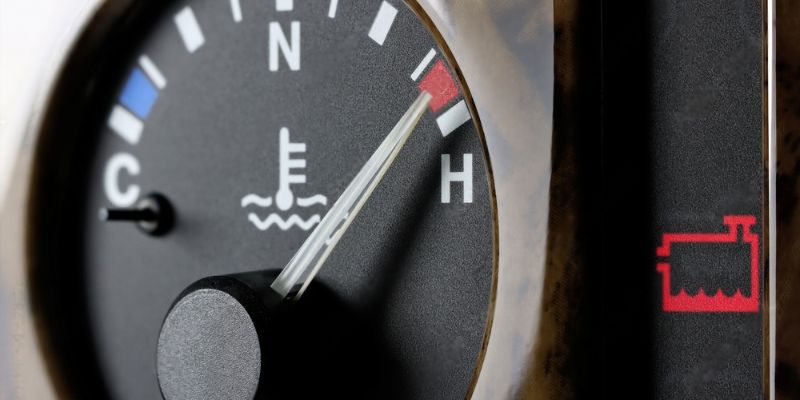Experiencing a situation where your car is running hot but not overheating can be concerning.
Understanding the possible causes and solutions for this issue can help you address the problem promptly and prevent potential damage to your vehicle.
In this article, we will explore the reasons why a car running hot but not overheating and provide practical solutions to resolve the issue.
Causes of a Car Running Hot but Not Overheating
When your car’s temperature gauge shows that the engine is running hot, but is not reaching the point of overheating, several potential causes could be at play.
Understanding these causes will help you diagnose the issue and take appropriate action to prevent further problems.
Below are some common culprits:
1. Low Coolant Level
A low coolant level is one of the most common reasons for a car running hot. Insufficient coolant in the system means there is not enough liquid to adequately absorb and dissipate heat.
This can lead to the engine running hotter than normal, even if it hasn’t reached the threshold of overheating.
2. Malfunctioning Thermostat
The thermostat plays a crucial role in regulating the engine’s operating temperature. If it becomes stuck in the closed position, it restricts the flow of coolant, preventing it from circulating properly through the engine.
As a result, the engine can heat up, causing the car to run hot.
3. Cooling System Blockage
A blockage in the cooling system can impede the flow of coolant, leading to overheating symptoms.
Common causes of blockages include debris, sediment, or rust buildup in the radiator, hoses, or heater core.
These blockages restrict the coolant’s ability to absorb heat efficiently, resulting in elevated engine temperatures.
4. Radiator Fan Problems
The radiator fan helps dissipate heat from the radiator by pulling air through the cooling fins. If the fan fails to operate correctly, it can’t cool the radiator effectively.
This can cause the engine to run hot, especially in traffic or during low-speed driving when there is insufficient airflow.
5. Water Pump Failure
The water pump circulates coolant throughout the engine, promoting heat transfer. If the water pump fails, it disrupts the proper flow of coolant, leading to inadequate cooling and increased engine temperature.
Common signs of water pump failure include coolant leaks, unusual noises, or excessive play in the pump’s pulley.
6. Faulty Temperature Sensor
The temperature sensor provides readings to the car’s temperature gauge, indicating the engine’s operating temperature.
A faulty sensor may send incorrect signals, causing the gauge to display high temperatures, even if the engine is not truly overheating. This can create the perception of a car running hot without reaching critical levels.
Identifying the root cause of your car running hot but not overheating can be challenging.
Solutions for a Car Running Hot but Not Overheating
If your car is running hot but not overheating, there are several solutions you can consider to address the underlying issues.
These solutions target the common causes mentioned earlier and aim to restore proper engine cooling.
Let’s explore some practical steps you can take:
1. Check and Refill Coolant Level
Start by checking the coolant level in the radiator and the coolant reservoir. If the level is low, it could be the cause of inadequate engine cooling.
Use the appropriate coolant recommended by your vehicle’s manufacturer and refill it to the proper level. Ensure that there are no leaks in the cooling system, as this could be contributing to the low coolant level.
2. Inspect and Replace the Thermostat
A malfunctioning thermostat can disrupt the coolant flow, leading to overheating symptoms. To address this, you may need to replace the thermostat.
Consult your vehicle’s service manual or seek professional assistance to locate and replace the thermostat correctly.
Consider using a thermostat of the appropriate temperature rating recommended for your vehicle.
3. Flush the Cooling System
If a blockage in the cooling system is suspected, performing a cooling system flush can help remove any debris, sediment, or rust buildup.
Flushing the system involves draining the coolant, using a coolant flush solution, and then thoroughly flushing the radiator, hoses, and heater core with water.
Follow our detailed guide on coolant flushing to perform this procedure correctly.
4. Inspect and Repair the Radiator Fan
Check the operation of the radiator fan to ensure it is functioning correctly. If the fan is not engaging or not running at the appropriate speed, it may need repair or replacement.
Inspect the fan motor, wiring, and any associated relays or fuses. Replace any faulty components as necessary to restore proper cooling airflow.
5. Replace a Faulty Water Pump
If the water pump is suspected to be the cause of inadequate coolant circulation, it may need to be replaced.
Look for signs of water pump failure, such as coolant leaks, unusual noises, or excessive play in the pulley.
Consult your vehicle’s service manual or seek professional assistance to replace the water pump correctly.
6. Test and Replace a Faulty Temperature Sensor
If you suspect a faulty temperature sensor, it’s recommended to have it tested or replaced.
A malfunctioning sensor can provide incorrect readings to the temperature gauge, causing false indications of high engine temperatures.
A professional mechanic with the necessary diagnostic tools can help identify and rectify sensor-related issues.
By implementing these solutions, you can address the common causes of a car running hot but not overheating.
However, if you are unsure about the cause or unable to resolve the issue on your own, it’s advisable to consult a qualified mechanic for a thorough diagnosis and proper repairs.
Safe Driving Practices During Overheating
When your car is running hot but not overheating, it’s important to practice safe driving habits to prevent further damage. Here are some guidelines to follow:
Pull Over to a Safe Location: If you notice your car’s temperature gauge rising or other signs of overheating, safely pull over to the side of the road or into a parking lot. Choose a location away from traffic to avoid any accidents or injuries.
Turn Off the Engine: Once you’ve pulled over, turn off the engine to allow it to cool down. Leaving the engine running may exacerbate the overheating issue and potentially cause more damage.
Open the Hood (if safe): If it’s safe to do so, open the hood to help dissipate heat more quickly. However, exercise caution as the engine and surrounding components may be extremely hot. Do not touch any hot surfaces or attempt to remove the radiator cap.
Do Not Add Cold Water: While it may be tempting to pour cold water into the radiator, it’s not recommended. The sudden temperature change can cause severe damage to the engine block. Wait until the engine has cooled down before adding coolant.
Call for Assistance: If you’re unable to resolve the issue or if the overheating persists, it’s best to call for professional assistance. A mechanic can diagnose the underlying problem and provide the necessary repairs.
For temporary fixes and additional guidance on handling an overheating car, you can refer to our guide on temporary fixes for overheating. It provides helpful tips for managing the situation until professional help is available.
FAQs
Q1: Why is my car running hot but not overheating?
A1: A car running hot but not overheating could be due to low coolant levels, a malfunctioning thermostat, a cooling system blockage, radiator fan problems, water pump failure, or a faulty temperature sensor.
Q2: Can a low coolant level cause a car to run hot?
A2: Yes, a low coolant level can lead to inadequate heat absorption and engine cooling, causing a car to run hot. Make sure to check and refill the coolant level if it’s low.
Q3: How can I check if my thermostat is functioning correctly?
A3: To check the thermostat, let your car run until it reaches operating temperature. Feel the radiator hoses to ensure they are both warm. If one hose remains cool while the other is hot, it suggests a malfunctioning thermostat.
Q4: What should I do if my radiator fan is not working?
A4: If your radiator fan is not working, it can lead to overheating. Check the fan motor, wiring, relays, and fuses for any issues. A faulty component may need repair or replacement to restore proper cooling airflow.
Q5: How do I know if my water pump is failing?
A5: Signs of a failing water pump include coolant leaks, unusual noises (such as grinding or squeaking), or excessive play in the pump’s pulley. If you observe these symptoms, consider replacing the water pump.
Q6: Can a faulty temperature sensor cause a car to run hot?
A6: Yes, a faulty temperature sensor can provide incorrect readings to the temperature gauge, leading to a car running hot without actually overheating. Testing or replacing the temperature sensor can help resolve this issue.
Conclusion
A car running hot but not overheating can be a puzzling situation that requires careful investigation. We have examined several potential causes that can contribute to this issue.
Low coolant levels, a malfunctioning thermostat, cooling system blockages, radiator fan problems, water pump failure, and faulty temperature sensors are common factors that can disrupt the engine’s cooling process.

Joseph Morgan has decades of automotive experience. The Detroit native started restoring classics in the 1970s. He owned a vintage repair shop and authored articles for car magazines. With a 1965 Mustang fastback of his own, Joseph now shares advice through his YouTube channel. From engine swaps to rust repair, his expertise helps preserve automotive history.
